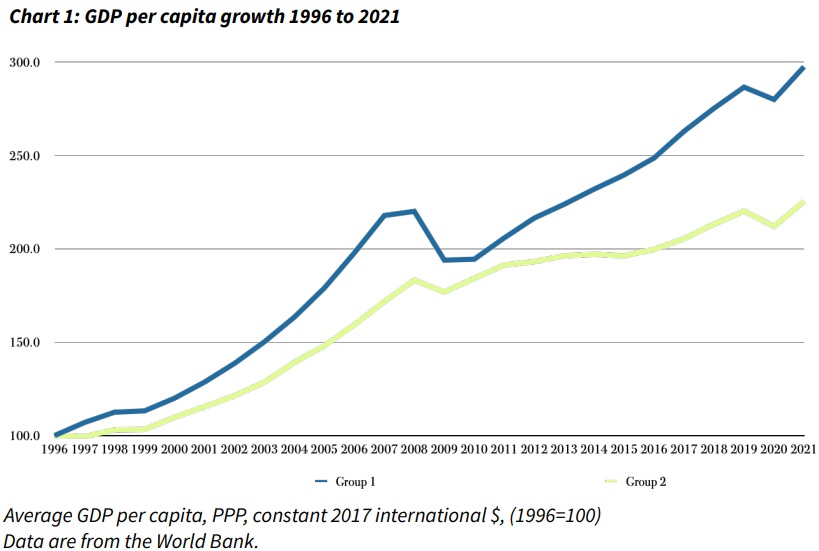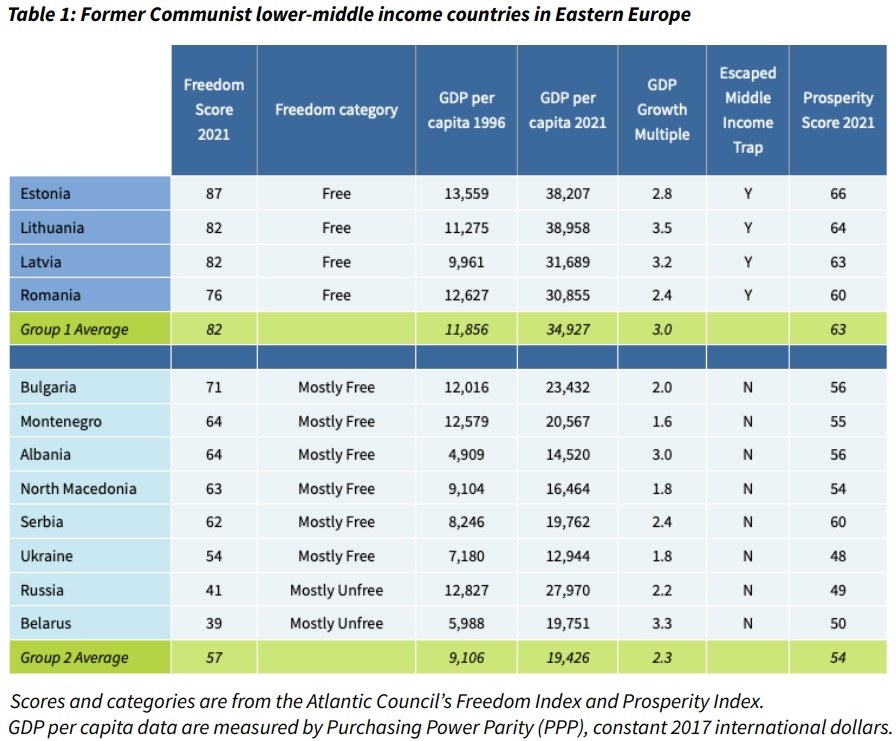I frequently call attention to my “anti-convergence club” because it shows – using decades of data – that you get more prosperity in nations with more economic liberty.
And that’s true everyplace in the world.
Including in Eastern Europe, as we can see from this comparison of pro-market reform nations (the dark blue line) and countries with more government (the light green line).
The chart comes from a new report, A World in Flux: Toward a New European Architecture, published by the Aspen Institute.
To be more specific, it comes from a chapter, authored by Dan Negrea, Joseph Lemoine, and Yomna Gaafar, that compares the nations in the region that done the most pro-market reforms with the ones that have lagged behind.
Here’s an excerpt.
Eastern European countries…were at a comparable development level at the time of the democratic revolutions that swept Eastern Europe in the late 80s and early 90s. But by 2021 the group was no longer homogenous: they had different levels of freedom, and some had experienced robust prosperity while others had stagnated at a middle-income level. …we show that the countries that experienced more political, economic, and legal freedoms enjoy greater prosperity.
Conversely, those which progressed less on the path of freedom are also less prosperous. …We first selected from among Europe’s formerly Communist countries a group with a comparable level of economic development in 1996, the first year with World Bank data for all post-Communist countries. …We then ranked these countries by their progress towards greater freedom by 2021 using the Atlantic Council’s Freedom Index. …We then created two groups. Group 1 includes all countries in the select group that are in the “free” category of this index. Group 2 includes all the other countries in our select group. Next, for countries in both groups, we compared their GDP per capita levels in 1996 and 2021, and calculated GDP growth multiples for each country and for both groups.
As already suggested by the above chart, Group 1 nations are doing much better than Group 2 nations.
If you want some of the details, here’s a table with a lot more information.
Back in September, Richard Rahn also wrote about economic freedom in Eastern Europe. Here are some excerpts from his column in the Washington Times.
…many of the former countries in Eastern Europe that were part of the Soviet Union or under the Soviet thumb have become some of the economically freest and most successful countries. …As a result of economic freedom, real incomes have also risen rapidly so most are now middle income – which is a sharp change from the poverty that they were mired in during Soviet times. The question is “Why did they do so well?” …Estonia was perhaps the best example of rapid constructive change. When the country gained full independence in 1991, its people elected a brilliant young history professor,
Mart Laar, who liked to say the only book he had ever read in economics was Milton Friedman’s “Free to Choose.” Mr. Laar said it sounded good to him so the Estonians went ahead and did it. As expected, the international bureaucrats at the World Bank, IMF, and foreign affairs departments of major countries recommended against going all out for economic freedom. …their advice was properly often ignored. …To this day, many of the former socialist countries have some of the world’s lowest debt-to-GDP ratios and are much more fiscally sound than most of the major countries. During a worldwide financial crisis, they will be the last ones to go bankrupt or resort to hyperinflation… Most the countries instilled more sensible new tax systems with low-rate or even flat taxes. Bulgaria has a simple 10% flat tax on both corporate and personal income.
Estonia is a success story, so I’m glad Richard discussed Mart Laar (one of the few admirable politicians in the world).
Now let’s share some bad news.
The demographic outlook in Eastern Europe is terrible. I wrote on that topic back in 2016.
And here are some excerpts from a column in the Washington Post by Charles Lane in late 2019.
The question now is whether the end might be near for Eastern Europe, demographically. …Of the 20 most rapidly shrinking countries in the world, 15 are erstwhile Warsaw Pact members, ex-Soviet republics or components of the former Yugoslavia (plus neighboring Albania). …Eastern Europe’s looming demographic crisis stems directly from its escaping the Soviet orbit in 1989.
Freedom of movement, coupled with membership in the borderless European Union, enabled millions of working-age people to leave the former Soviet bloc for work in the more prosperous West. Emigration, plus low and declining birthrates — a characteristic of modern society that Eastern Europe shares with Western Europe and the United States — has resulted in whole villages hollowing out, with only pensioners left behind. …Demographic decline is extremely difficult to reverse, wherever it occurs. As experience has shown in various countries, governments cannot do much to raise birthrates, even with generous subsidies for families with children.
Needless to say, the situation has not improved. Though it will be interesting to see whether the huge baby subsidies in Hungary will make a difference.
But since I’m skeptical of that approach, I’ll close by noting that Eastern Europe’s demographic decline is a recipe for fiscal disaster because there won’t be enough future taxpayers to pay benefits that have been promised to the elderly.
 This is a problem in many nations, of course, but it’s a crisis in Eastern Europe.
This is a problem in many nations, of course, but it’s a crisis in Eastern Europe.
For what it’s worth, “pre-funding” is probably the only practical way of dealing with demographic decline, and this means big reforms such as personal retirement accounts.
This is feasible. Jurisdictions such as Hong Kong and Singapore also are facing demographic decline, but they are in a much stronger position because they don’t have tax-and-transfer welfare states. People are required to save for their own retirement.
The bottom line is that Eastern European nations need to engage in a lot more reform (especially self-funding for things like Social Security and health care) if they want to continue to make economic progress.
P.S. Here’s one final excerpt, dealing with membership in the European Union, from the chapter that we discussed at the start of the column.
…for Eastern Europe’s former Communist countries, the EU’s rules and standards catalyzed national consensus for reforms to make a clean break with their former malefic and malfunctioning Communist political and economic system. Today, EU support for reform in candidate member states, culminating in their EU membership, is a propellant for freedom and prosperity in these countries.
Notwithstanding my general disdain for the European Union, I agree that membership is good for Eastern European nations.
Not because they get subsidies, of course, but because EU membership means better rule of law.


[…] let’s take a closer look at how Poland has recovered from socialism. And we’ll start with this chart showing much better economic performance after the […]
[…] On the other hand, I have tepidly written that E.U. membership may make sense for nations from Eastern Europe. […]